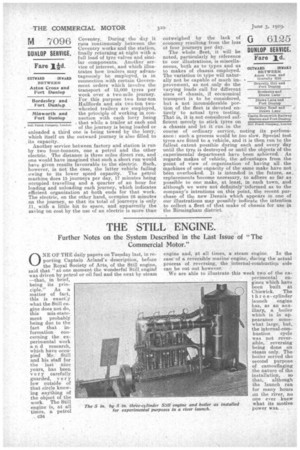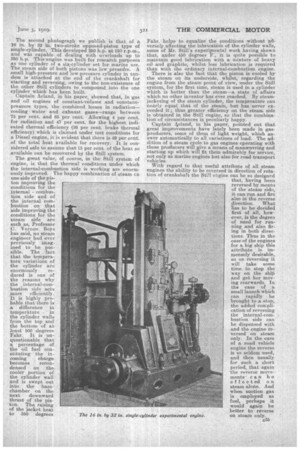THE STILL ENGINE.
Page 12

Page 13

If you've noticed an error in this article please click here to report it so we can fix it.
Further Notes on the System Described in the Last Issue of "The Commercial Motor."
that circle know , . mg anything of the object of the work. The Still engine is, at all times, a petrol engine and, at all times, a steam engine. In the case of a reversible marine' engine, during the actual process of-. reversing, the internal-combustion side can be cut out however.
We are able to illustrate this week two of the experimental engines which have been built at Chiswick. The thr e ecylinder launch engine has, as an auxiliary, a .boiler which is in appearance somewhat large, but, the internal-combustion cycle was not reversible, reversing being done on steam only. The boiler served the second purpose of camouflaging the nature of the installation, so that, although the launch ran for many hours on the river, no one ever knew what its motive power was.
installed The second . photograph we publish is that of a 16 in. by 32 in. two-stroke opposed-piston type of single-cylinder. This developed 250 h. p. at 150 r.p.m., and was capable of dealing with overloads up to 350 h.p. This engine was built for research purposes as one cylinder of a six-cylinder set for marine use. The steam side of both pistons was low pressure. A. small high-pressure and low-pressure cylinder in tandem is attached at the end of the crankshaft for starting and reversing, owing to the non-existence of the other Still cylinders to compound into the one cylinder which has been built.
Captain A.cland, in his paper, showed that, in 'gas and oil engines of constant-volume and -constantpressure types, the combined losses in radiation— cooling water and exhaust gases—range between 75 •per cent. and 65 per cent. Allowing 4 per cent. for radiation and 47 per cent, for the highest, indiea,ted thermal efficiency (36 per cent. brake thermal efficiency) which is claimed under test conditions for a Diesel engine, it is evident that there is 49 per cent. of the total heat available for recovery: It is considered safe to assume that 15 per cent, of the heat so available can be recovered by the Still system.
enormously reduced is one of the reasons why the internal-combustion side acts more efficiently. It is highly probable that there is a difference in temperature • in the cylinder walls from the top and the bottom of at least 500 degrees Fahr. It is unquestionable that a percentage of the oil fuel constituting the in
coming charge becomes recondensed on the. cooler portion of the cylinder wall and is swept out into the basechamber on the next downward thrust of the piston. The raising of the jacket heat to 350 degrees Fahr. helps to equalize the conditions without'adversely affecting the lubrication of the cylinder walls, some of Mr. Still's experipental work having shown that, under 450 degrees F., it is quite possible to maintain good lubrication with a mixture of heavy oil and graphite, whilst less lubrication is required than with the ordinary internal-combustion engine.
There is also the fact that the piston is cooled by the steam on its underside, whilst, regarding the engine from the steam point of view, under the Still system, for the first time, steam is used in a cylinder
i
which s hotter than the steam—a state of affairs which no other inventor has ever reached. By steamjacketing of the steam cylinder, the temperature can nearly equal that of the steai:a, but has never exceeded it ; thus greater efficiency on the steam side is obtained in the Still engine, sothat the combination of circum-stances is peculiarly happy.
Captain 4clancl, in his paper, pointed out that great improvements have lately been made in gasproducers, some of them of light weight, which answer automatically to all variations of load. The addition of a steam cycle to gas engines operating with these producers will give a means of manoeuvring and starting up which will fit them admirably for service, not only as marine engines but also for road transport vehicles.
With regard to that useful attribute of all steam engines the ability to be reversed in direction of rotation of crankshaft the still engine can be so designed that, having been reversed by means of the steam side, it can run and fire also in the reverse direction. What as to be decided first of all, however, is the degree of need for running i and also firing n both directions. Thus in the case of the engines for a big ship this attribute is immensely desirable, as on reversing it will take some time to stop the way on the ship and get her moving rearwards. In the case ofa small launch which can rapidly be brought to a stop, the added complication of reversing the internal-combustion side can be dispensed with and the engine reversed on steam only. In the case of a road vehicle engine the reverse is so seldom used, and then usually for such a short period, that again the reverse movements' can be effected on steam alone. And when suction gas is employed as fuel, perhaps it would again be better to reverse on steam only.






















